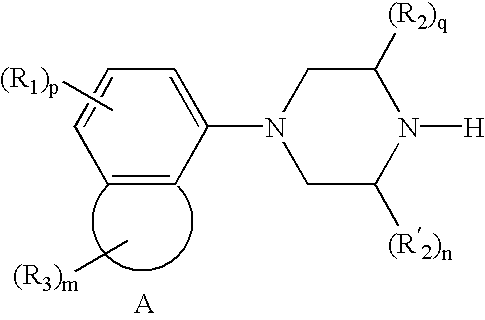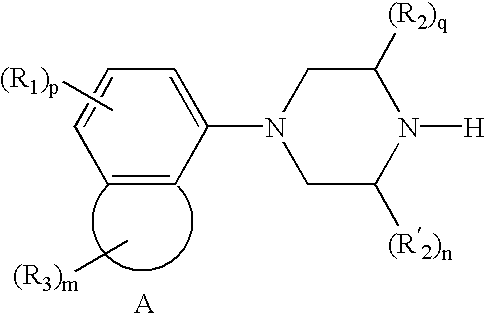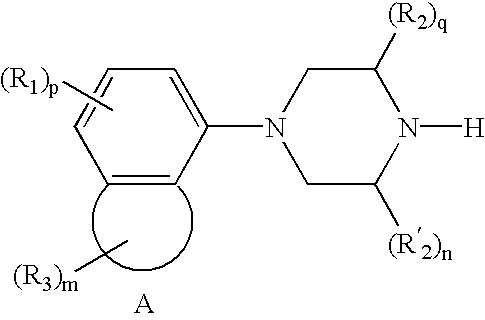Treatment for attention-deficit hyperactivity disorder
a hyperactivity disorder and attention deficit technology, applied in the field of treatment of attention deficit hyperactivity disorder, can solve the problems of affecting the development of attention deficit or inattention, so as to minimize side effects
- Summary
- Abstract
- Description
- Claims
- Application Information
AI Technical Summary
Benefits of technology
Problems solved by technology
Method used
Image
Examples
example 2
[0087] The following results were obtained using the methods described in Example 1. Eltoprazine was investigated using a very wide dose range: 0.1-4 mg / kg. FIG. 2 demonstrates decreased cognitive enhancement at higher doses of eltoprazine. At 1, 2, and 4 mg / kg eltoprazine, the performance curves were flatter than the saline curve (FIGS. 2A, 2B, and 2C, respectively). ANOVA revealed a significant dose main effect, p<0.001, and a significant dose.times.trial time interaction, p<0.01.
[0088] At lower doses of eltoprazine, however, cognitive enhancement was observed, as illustrated in FIG. 3. In two separate studies of 0.1 and 0.9 mg / kg eltoprazine, the peaks of the response curves are higher and the curves are sharper. Times at which pairwise comparisons between saline and amphetamine reached significance are indicated on the graphs. ANOVA revealed a significant dose main effect in one study, p<0.001, and a significant dose.times.trial time interaction in both studies, p<0.01. In concl...
example 3
[0089] The coloboma (Cm) mutant mouse has been proposed as a rodent model for ADHD (for review, see Wilson, Neurosci. Biobehav. Rev., 24:51-57, 2000). The rationale for this proposal is three fold: first, Cm mutants (heterozygote) exhibit elevated spontaneous locomotor hyperactivity which averages three to four times the activity of wild-type littermates (Hess et al., J. Neurosci., 12:2865-2874, 1992; Hess et al., J. Neurosci., 16:3104-3111, 1996); second, this Cm mutation-associated hyperactivity can be ameliorated by low and moderate doses (2-16 mg / kg) of D-amphetamine (Hess et al., 1996, supra), a psychostimulant commonly prescribed to treat ADHD; and lastly, Cm mutant mice exhibit delays in achieving complex neurodevelopmental milestones in behavior (Heyser et al., Brain Res. Dev. Brain Res., 89:264-269, 1995) and deficits in hippocampal physiology and learning performance (Steffensen et al., Synapse, 22:281-289, 1996; Raber et al., J. Neurochem., 68:176-186, 1997) which may cor...
example 4
[0104] Eltoprazine-induced normalization of locomotion in Cm mutant mice was found not to be associated with altered exploratory preference or frequency of rearing. Although some researchers have argued that eltoprazine may enhance neophobia in rodents (Rodgers et. al., Behav. Pharmacol., 3:621-634, 1992; Griebel et al., Psychopharmacology (Berl), 102:498-502, 1990), the doses (1.25 mg / kg or higher) and the tests used (elevated plus maze or light-dark box) in these studies were different from those used in the present study.
[0105] Open-field testing was performed as described in Example 3. Rodents by nature are neophobic as measured by two parameters in the open-field test including: exploratory preference for the periphery over center of the arena and the frequency of rearing. Eltoprazine did not alter either parameter in this study. As FIG. 6 illustrates, eltoprazine had no effect on exploratory preference in either Cm or wild-type mice. Animals of both treatment groups spent a co...
PUM
| Property | Measurement | Unit |
|---|---|---|
| concentration | aaaaa | aaaaa |
| concentration | aaaaa | aaaaa |
| concentration | aaaaa | aaaaa |
Abstract
Description
Claims
Application Information
 Login to View More
Login to View More - R&D
- Intellectual Property
- Life Sciences
- Materials
- Tech Scout
- Unparalleled Data Quality
- Higher Quality Content
- 60% Fewer Hallucinations
Browse by: Latest US Patents, China's latest patents, Technical Efficacy Thesaurus, Application Domain, Technology Topic, Popular Technical Reports.
© 2025 PatSnap. All rights reserved.Legal|Privacy policy|Modern Slavery Act Transparency Statement|Sitemap|About US| Contact US: help@patsnap.com



